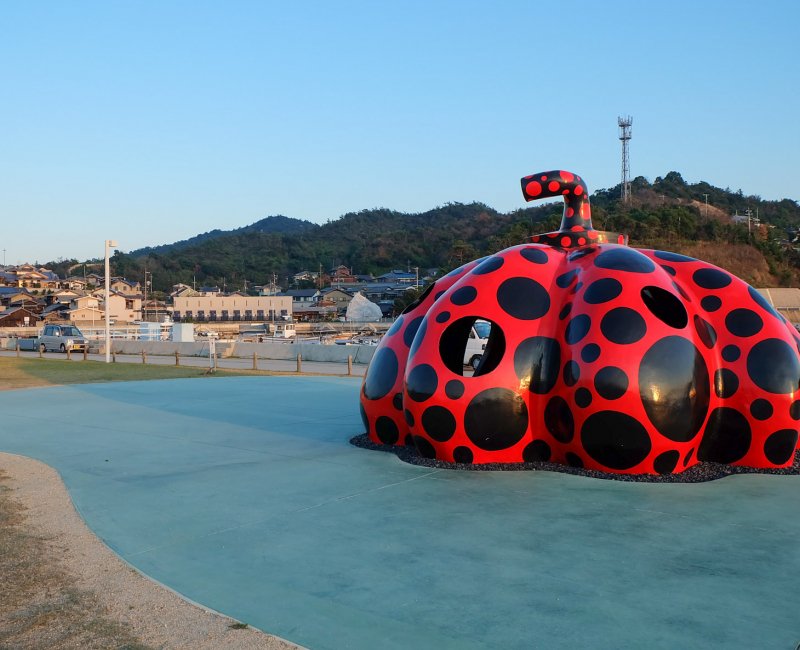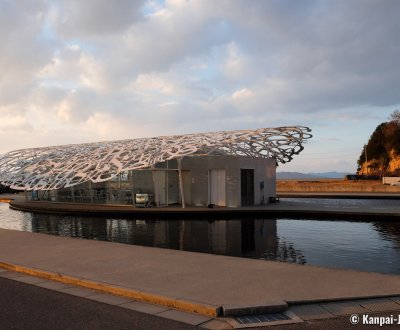Setouchi Triennale
Contemporary Art in the Inland Sea’s Islands
Setouchi Triennale is an important international contemporary art festival taking place every 3 years on a dozen of islands in the Seto Inland Sea, located in Kagawa and Okayama prefectures in Japan. Both artistic and touristic, it is a unique discovery of the archipelago’s rural islands .
Japan’s fragmented territory and its wonderful natural landscapes are the perfect canvas for contemporary art. Moving away from the larger cities allows the discovery of artistic gems either nestled in a luxurious vegetation or facing the ocean’s immensity. A few places come to mind, such as:
- Hakone Open-Air Museum,
- Enoura Observatory in Odawara,
- Miho Museum in Otsu’s countryside, or,
- Towada and Kanazawa’s Museums of Contemporary Art.
Snug between the 2 large islands of Honshu and Shikoku, the Seto Inland Sea is home to hundreds of mainly rural and antiquated little islands, of which a few have become the ideal setting for the Setouchi International Art Festival, officially named the "Setouchi Triennale".

A triennial and seasonal event
First set up in 2010, the Setouchi Triennale takes place every 3 years, and the 5th Triennale staged in 2022 is themed on "Uncovering the hidden resources of Setouchi". The event is divided into 3 key-periods, following the seasons:
- Spring: April 14 to May 18,
- Summer: August 5 to September 4,
- Autumn: September 29 to November 6.
During these highlights, animations and temporary events are staged and give depth to the exhibitions. It is important to know that part of the artworks, especially the outdoor ones, form a permanent exhibition and are therefore viewable any time beside the festival periods.
The Setouchi Triennale was popular from its first edition, with about 1 million visitors, a figure that was exceeded in the following years; the 2019 Triennale for example was visited by 1,178 484 persons. The event’s international reputation attracts amateurs from all over the world, who discover a large contemporary art exhibition showing hundreds of world-class artists as well as a local cultural heritage preserved by the communities.
Including Takamatsu and Uno ports, a dozen of islands affiliated to Kagawa and Okayama prefectures are part of the Setouchi Triennale, and most are only reachable by boat. The festival takes place on the eastern side of the Inland Sea, on each side of the Great Seto bridge, and does not extend to Hiroshima prefecture.

Conceptual islands at the crossroads of art and heritage
One of the main goals of the Setouchi Triennale is to revive the area through cultural tourism and to value its heritage, be it natural or historical. Each selected island has indeed its individual past, and artworks placed on their territory echo this history in a travel both in sight and back in time:
- Naoshima (直島), the most famous of the Setouchi islands and the Triennale’s showcase, was the first to develop an artistic offer under the impetus of the "Benesse Art Site Naoshima" collective. Several museums and architectural structures, sometimes in collaboration with Tadao Ando, were thus built in the early 1990s. Copper smelting, sea freight and aquaculture were the island’s main historical industries.
- Teshima (豊島) was a wealthy island, with agricultural lands, terraced rice fields, fishermen villages and dairy cattle. After an illegal dumping of industrial waste in the 1970s, the islanders have become very concerned with the preservation of the environment. The art facilities, including the Teshima Art Museum, are also operated by the Benesse House.
- Shodoshima (小豆島) is one of the largest islands in the Seto Inland Sea, specialized in the cultivation of olive tree and olive oil production. Great skills were also developed in the artisanal production of typically Japanese products such as the shoyu soy sauce, somen noodles and tsukemono pickles. Its mountains and beautiful sand beaches complement the touristic offer and attractiveness of the contemporary art harmoniously blending into the landscape.
- Inujima (犬島) is the 3rd island operated by the "Benesse Art Site Naoshima" displays artworks in connection with its industrial past of granite extraction and copper smelting.
- Ogijima (男木島) is home to a lovely fishing village spreading on the side of the mountain and overlooking the island’s main port, where most of the ferries and boats dock. Its crooked narrow streets offer an easy stroll.
- Megijima (女木島) is related to Momotaro’s legend with a huge cave that is said to be the place where Onigashima island’s demons lived in the tale.
- Oshima (大島) is a former leper colony, where art meets the medical field and the hospital.
- Honjima (本島) showcases the authentic architecture of its feudal port district dating back to the Edo period (1603 - 1868).
- Shamijima (沙弥島) is a peninsula, connected to Sakaide City on the north-eastern coast of Shikoku. The access is easy by car from Takamatsu to visit outdoor installations with a superb view on the Great Seto Bridge.
- Awashima (粟島) is home to a former school of the Japanese Navy, whose wooden buildings painted in a celadon green were preserved and are now open to the public.
- Takamijima (高見島) is a deserted island that used to be specialized in the cultivation of Pyrethrum, a plant used as a natural insecticide and mosquito repellent. The main port village offers both urbex and artistic itineraries, between the many abandoned houses.
- Ibukijima (伊吹島) is the westernmost island of the Triennale. This small land is renowned for its activities of sardine and anchovy fishing. The fish is dried and packaged on site in a local plant. People still talk the same dialect as during the Heian period, when Kyoto was the imperial capital of Japan.
Exhibited in the open-air or sheltered in a renewed traditional building, the artworks harmoniously blend in the local life. The most distinctive and often imposing ones flourish in the landscape and have become over time the symbols of their respective islands, such as the famous giant colored pumpkins by Yayoi Kusama in Naoshima.

The mix of contemporary art with a rural, somewhat forsaken, island setting is a success. The inhabitants, who are for a large part elderly farmers and fishermen, benefit from this renewed attention and some even take an active part in the festival alongside the exhibitors by welcoming visitors. Art is envisioned as a mean to a sustainable dialog between the peoples and the better protection of the natural environment.
Make sure to thoroughly prepare your visit in advance, especially regarding the frequency of the sea shuttles as well as booking the accommodation on the islands. Walking is easy on the smallest ones, and cycling, or riding a bus are a good solution on the bigger ones. It is not necessary to visit all the islands to have a good grasp of the festival and we recommend spending 1 to 3 days at the Triennale a time to adjust according to how many islands one wants to explore.



